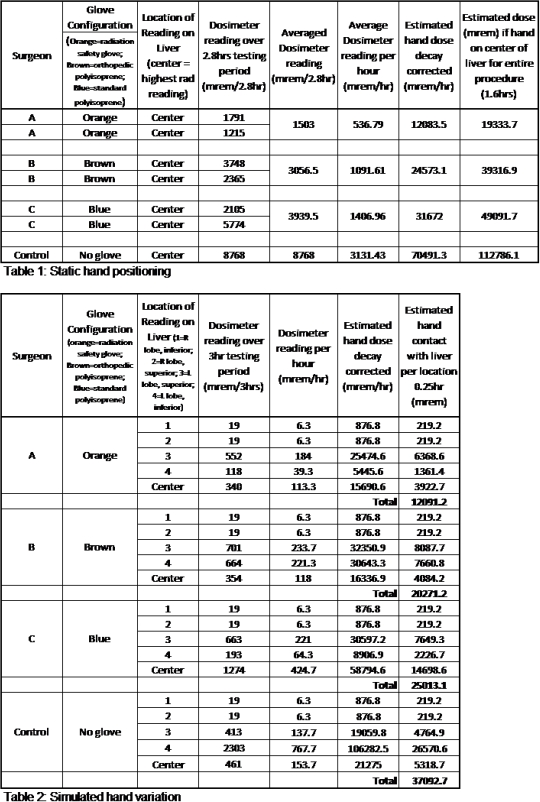Radiation Exposure to the Transplant Surgeon: A Case Study of Recent Yttrium-90 Treatment in an Explanted Liver
1Organ Transplantation, Scripps Green Hospital, La Jolla, CA
2Medical Physics & Radiation Safety, Scripps Green Hospital, La Jolla, CA.
Meeting: 2018 American Transplant Congress
Abstract number: B265
Keywords: Hepatocellular carcinoma, Liver transplantation, Safety
Session Information
Session Name: Poster Session B: Liver: Hepatocellular Carcinoma and Other Malignancies
Session Type: Poster Session
Date: Sunday, June 3, 2018
Session Time: 6:00pm-7:00pm
 Presentation Time: 6:00pm-7:00pm
Presentation Time: 6:00pm-7:00pm
Location: Hall 4EF
BACKGROUND: Yttrium-90 (Y-90) radioembolization for the treatment of hepatocellular carcinoma can present safety challenges to the surgeon when transplanting a recently treated Y-90 patient. To reduce surgeons' contact with radioactive tissue and remain within occupational dose limits (≤50 rem annually), guidelines recommend delaying abdominal operations for 30 days. OBJECTIVE: Assess surgeon hand exposure to ionizing radiation during liver explantation in the setting of recent Y-90 radioembolization. METHODS: An ex-vivo radiation exposure analysis was conducted on the explanted liver of a patient who received Y-90 therapy 48 hours prior to orthotopic liver transplant. Three different surgical glove configurations were used by each surgeon involved with the explantation. To estimate surgeon hand exposure, radiation dosimeter rings were placed inside each glove type and exposed to the explanted liver. Estimated radiation dose per hour (corrected for Y-90 decay) was calculated for static and varying hand positions on the liver. RESULTS: Radiation safety surgical gloves showed an average radiation exposure rate of 536 mrem/hr and total decay corrected (TDC) estimated hand dose of 12083 mrem/hr in the static hand position (83% reduction in exposure over controls with no glove [3131 mrem/hr, TDC 70491 mrem/hr]). Non-radiation safety gloves (brown & blue polyisoprene) also showed reduced exposure rates of 1091 and 1406 mrem/hr respectively and TDC estimated hand doses of 24573 and 31672 mrem/hr, well below regulation limits. Varied hand location showed parallel results, with radiation safety gloves performing best (67% radiation exposure reduction over controls). CONCLUSIONS: Surgeon handling of Y-90 radiated organs within 30 days of treatment can be done safely and does not exceed federal occupational dose limits if appropriate gloves and precautions are utilized. Surgical glove configuration has significant impact on radiation dose exposure to surgeons' hands and should be considered when developing institutional radiation safety protocols.
CITATION INFORMATION: Decoteau M., Lewis P., Steuterman S., Schaffer R., Fisher J., Case J., Marsh C. Radiation Exposure to the Transplant Surgeon: A Case Study of Recent Yttrium-90 Treatment in an Explanted Liver Am J Transplant. 2017;17 (suppl 3).
To cite this abstract in AMA style:
Decoteau M, Lewis P, Steuterman S, Schaffer R, Fisher J, Case J, Marsh C. Radiation Exposure to the Transplant Surgeon: A Case Study of Recent Yttrium-90 Treatment in an Explanted Liver [abstract]. https://atcmeetingabstracts.com/abstract/radiation-exposure-to-the-transplant-surgeon-a-case-study-of-recent-yttrium-90-treatment-in-an-explanted-liver/. Accessed December 26, 2025.« Back to 2018 American Transplant Congress
